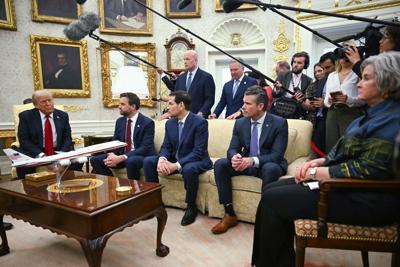Donald Trump is doing . The latest round includes a new 35 per cent rate on Canada effective Aug. 1, on top of existing “sectoral tariffs” like those on steel. He’s also targeting the EU and Mexico with 30 per cent tariffs. Overall, he’s threatening higher tariffs than he did for April 2’s so-called Liberation Day.
The routine is familiar: threats, announcements, executive orders, press conferences, social media posts — followed by exceptions, delays, and sudden pauses. He paused Liberation Day tariffs once the markets crashed and then promised 90 agreements in 90 days. Maybe two preliminary deals have surfaced in the 100 days since. Last week came letters to world leaders, riddled with bad grammar, victimhood, and errors — one even addressed a female leader as “Dear Mr. President.” Canada got its letter Friday.
For us, Trump is blaming fentanyl again. For the EU, whose non-agricultural tariff is 1 per cent, and for Mexico, a partner in the USMCA signed in Trump’s first term, he declared America’s trade deficit “a major threat to our Economy and, indeed, our National Security!” Brazil, despite its U.S. trade deficit — is facing a 50 per cent tariff, likely because Trump’s ally and fellow authoritarian-populist, Jair Bolsonaro, may face consequences for Brazil’s version of Jan. 6.
What is Trump’s long-term strategy? There’s no evidence he has one. After a decade of tariff talk, he remains incoherent. Tariffs are taxes — estimated to cost average Americans $2,400 per year. They stifle exports and fuel inflation. A few steel jobs in Pittsburgh might come at the cost of many more jobs elsewhere. And a trade deficit doesn’t mean you’re being cheated or subsidizing another country. These basics elude Trump, or he refuses to acknowledge them.
Yet, there’s an American industry making Trump’s chaos sound like policy. In the name of “balanced journalism,” media outlets explain his bluster as if it’s strategic. The New York Times recently said: “Mr. Trump is willing to upend long-held relationships in his quest to rewrite the rules of global commerce.” Please. Quests take planning. Trump cares about global trade rules like he cares about election integrity.
Cable channels dig up the one economist in 100 who likes tariffs. Sunday shows hand microphones to loyalists who dress up chaos as “short-term pain for long-term gain” while mythologizing the great dealmaker and lengthening the con. But it’s not 3-D chess. It’s improvisation, illogical and lies.
We can stretch to understand Trump’s actions as policy that pursues America’s interests. Tariff threats might be a good way to get other countries to remove their own. But Trump threatens countries like Korea, which have free trade with the U.S.
Really, the logic only works from his perspective. This is what strength looks like to him. He thinks he sounds smart and a few new factories make him feel that way. He wants to bully countries and leaders because that’s who he is.
Also, Trump wants more power and having angry Americans facilitates him grabbing it. The more things unravel, the more lines he’ll cross, claiming necessity. That’s how authoritarianism spreads. Whether it’s Democrats, immigrants, or unfair trade policies, someone else always gets the blame. If a recession is declared this month, he’ll need scapegoats.
Trump’s real edge? He doesn’t care about the harm he’s causing to average Americans, including his own supporters. During COVID, he prioritized optics over lives. Don’t expect him to care if Canadians skip cross-border trips this summer. He’s also buoyed by the endless self-harm his supporters will endure before blaming him — they’ll call it sacrifice for making American great again.
So what is Canada and the world to do? We are witnessing a democracy in steep decline and the collapse of American leadership in the world. We might hope for extensions, pauses and reversals if markets tank or polls dip. But Trump probably already understands the essential truth: the spectacle is more valuable to him than the tariffs themselves.
Error! Sorry, there was an error processing your request.
There was a problem with the recaptcha. Please try again.
You may unsubscribe at any time. By signing up, you agree to our and . This site is protected by reCAPTCHA and the Google and apply.
Want more of the latest from us? Sign up for more at our newsletter page.




























To join the conversation set a first and last name in your user profile.
Sign in or register for free to join the Conversation